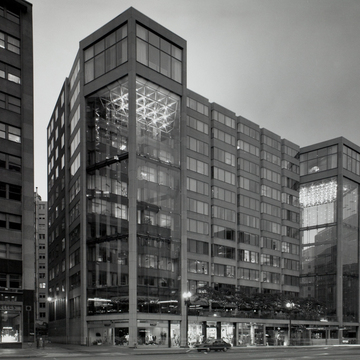In a very real sense, the crossing of Connecticut Avenue and L Street can be claimed by Washington-based architect Chloethiel Woodard Smith. She designed three of the four corner buildings. The northeast corner building, situated over the multilevel shopping and restaurant mall called the Connecticut Connection, was designed by Skidmore, Owings and Merrill. Smith's Blake Building (
DW09.1) at the southeast corner resembles a finely curved computer card that turns the corner. At the northwest corner, her 1100
In the massive Washington Square project, Smith best exemplifies the modern design approach to new office blocks of the 1980s. With two glass towers at the north and south corners, the structure breaks out of the glass box formula. Stretching west an entire city block, Washington Square offers upscale shopping at the street level and at a groundlevel mall closest to Connecticut Avenue. The entire composition is defined with glass ribbon windows, projecting at equal intervals to create the effect of projecting bays.

